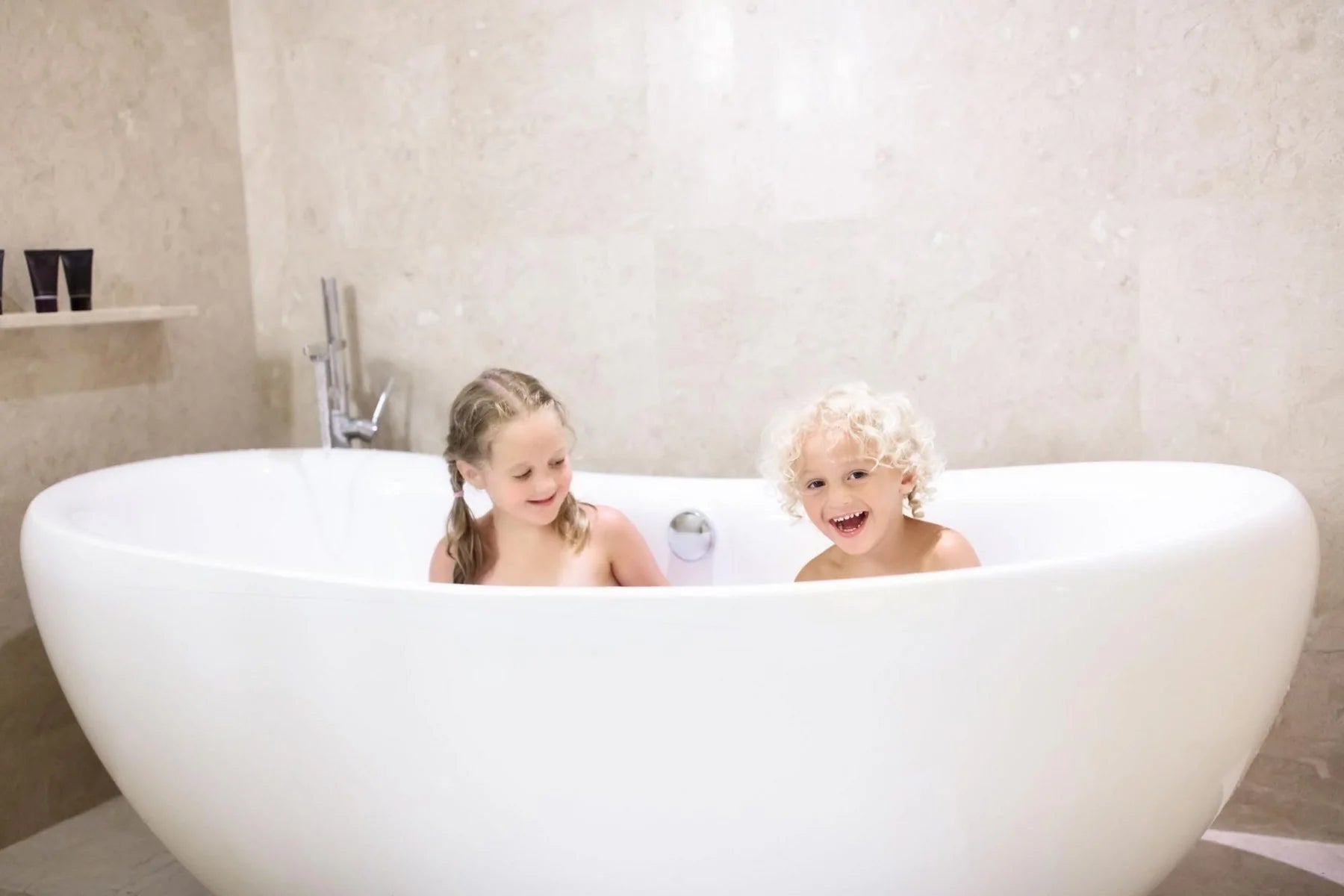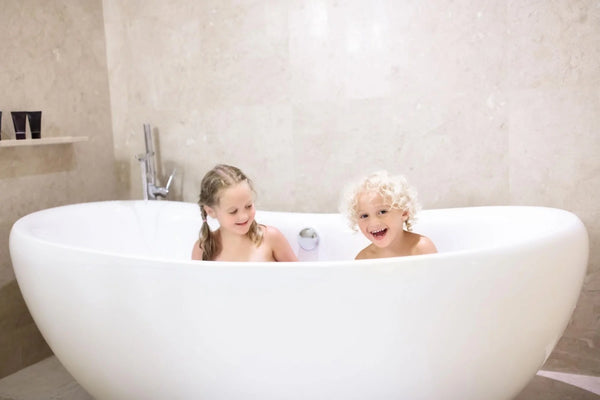From toy organization to non-slip tubs, there are dozens of things to think about when designing a bathroom for children. While safety is the most important concern in a child’s bathroom, creating a kid-friendly bathroom doesn’t mean you have to sacrifice style.
After all, adults and guests will likely use those bathrooms too, and you’ll want a space that can accommodate everyone. Whether you’re remodeling an existing children’s bathroom or designing a new one, these tips for child-safe bathrooms will help you style an accessible space that’s inviting, playful and hazard-free.
Designing a Bathroom Safe for Kids
Since safety is the most important concern when designing a child’s bathroom, it’s best to consider this element first. Then, the rest of the bathroom can be designed around these core safety principles.
The first thing to think about is non-slip floors and bathtubs. Small tiles tend to create less slippery floors due to the many grout lines on the surface, according to Century Tile and Carpet. This makes mosaic tiles a strong choice: In addition to being small, they offer opportunity for interesting, colorful designs that keep kids’ bathrooms playful.
Gloss is another thing to keep in mind when choosing tiles for a children’s bathroom. Gloss tiles tend to be slippery when wet, while textured tiles have a rougher surface which can prevent slips, says home design writer Sarabeth Asaff. Porcelain tiles come in polished, matte and textured finishes, all of which have different benefits and drawbacks. Matte and textured tiles are best for non-slip floors, but even polished tiles can be made less slippery through the application of an impregnating sealer. Applied to prevent dirt from collecting in small grooves in the tile, the sealer also increases the slip-resistance of the tile, she explains.
Understanding COF ratings can also help you decide on a slip-resistant tile, says home improvement expert Lee Wallender. The rating helps determine how slippery a tile surface is, and is based on a test that replicates real-world bathroom environments.
“Higher COF slip resistance numbers are better than lower numbers. Clean, dry items moving against each other tend to have COF ratings ranging from 0.3 to 0.6. Very slippery items can dip as low as 0.04, with zero meaning that the two items have no friction at all,” he explains. Simply ask your flooring retailer to point you to the types of tiles that have a high slip resistance rating.
Aside from creating a non-slip environment, you can adjust your water heater, says Andrea Davis at Improvenet. “It's suggested that you keep the water heater around 110 degrees when there is a baby in the home. This will help keep anyone in the home from accidentally causing burns to themselves or anyone else.”
Anchoring furniture to the wall is another easy but important safety consideration if you have young children, says lifestyle blogger Chelsea McDonnough. Unanchored toilet racks, for example, can fall forward if they’re loaded with heavy items. Fortunately, anchoring shelving units, vanities and other pieces of bathroom furniture is simple with a drill, stud finder and some furniture strap kits.

Child Accessibility Considerations
Since children are smaller than adults, there are certain design elements that can make the bathroom experience better for them.
One idea is to make the tub more accessible by adding a graduated step, suggests Kristin Hampshire at HGTV. This way, kids can get in and out of the bathtub without having to swing their legs and bodies over the edge, which can be dangerous when they’re wet. A second hand-held shower head on a lower bar can also make it easier for parents to rinse their children.
Stepping stools help kids reach the sink and see in the mirror when brushing their teeth and washing their hands. Emma Finley at Sunrise Specialty says to invest in sturdy stepping stools at different heights. Store them under the sink ensures they don’t cause a tripping hazard when not in use. For something sleeker, consider a built-in step stool that can be tucked inside the vanity. This is a stylish way to accommodate both children and adults in the bathroom, says the team at SEI Construction.
In addition to making certain things more accessible, you’ll also want to think about what you don’t want children to have access to. Keeping cleaning products and medicines out of reach and locked away prevents children from accidentally ingesting them.
“Medicine, cleaning products, chemicals and beauty products need to be kept high, out of reach, preferably in a locked cabinet. Do a scan of any reachable areas in the bathroom to check for liquids or toiletries that could be damaging in the wrong hands,” writes Erica Garland at Kids in the House.

Child-Friendly Storage
Without designated storage for toys and kid’s products, children’s bathrooms can get messy fast. That’s why it’s so important to create a system for storing everything neatly and safely away when its not in use.
“Storage space is vital in any bathroom, but especially in a kids’ bathroom where you’ll want to be able to quickly and conveniently tuck clutter away. From vanity storage to cute baskets or other containers, there are lots of ways to incorporate more storage space into your bathroom,” says Erica Garland at Modern Bathroom.
One idea that works great for kids is to create a system or code for how to put things away neatly. Create designated buckets or totes for each child and then store them out of sight beneath a linen closet or in a drawer so they don’t cause clutter, writes child therapist and blogger Becky Mansfield of Your Modern Family. “Fill the bags with each child’s toiletries—deodorant, makeup, hair supplies or whatever else they might need. This is particularly helpful as the kids get older.”
This also makes it easy for children to go on trips or have sleepovers, as everything they use daily is already organized in one location.
Custom drawer dividers are another smart choice, especially in bathrooms with teens who may use extra styling and beauty products, says Debra Steilen at Better Homes and Gardens. Different drawers can be designated for different children or organized by supply type to keep things organized. Drawer inserts are smart because they can be reorganized quickly and make use of the entire drawer space.
When it comes to hooks, knobs and drawer pulls for storage, some designs are much more child-friendly than others. For example, Somewhat Simple blog founder Stephanie Dulgarian explains that towel hooks are much easier for kids to use than towel bars. She swapped out a towel bar for three monogrammed towel hooks that are equal parts stylish, personalized and kid-friendly.
Lastly, keep in mind that your children won’t be small forever. It’s easy to get caught up in adorable baby themes and toddler-friendly decor, but don’t forget about the future, suggests the team at stone tile retailer Marmol. “Unless you plan to completely redo your child’s bathroom every few years, stick with design concepts that provide room to grow.” Children grow up fast, and you’ll want to design a bathroom that can accommodate them both now and throughout their teen years.
Images by: famveldman/©123RF.com, Bernard Bodo/©123RF.com, famveldman/©123RF.com







